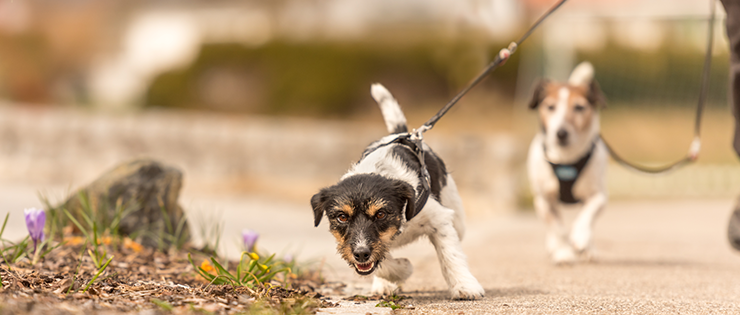
For many, the idea of going for a walk with a dog who pulls on lead elicits a range of emotions. It is frustrating, tiring, stressful and can be dangerous and painful! There is good news however, and that is, pulling on lead is a learned behaviour and can be managed easily with the right training. So don't despair.
The first step to overcoming this issue is to invest some time into understanding why your dog pulls. The main reasons for pulling on lead are that your dog is excitable and full of energy, they are anxious and unsure of what to do, or a combination of both. When you think about dog behaviour from the dog's point of view, going for a walk is overloaded with sights, smells and sounds. It is often the most stimulating part of their day, after likely being alone for a long period of time and to your dog, the walk is their opportunity to experience the world. Pulling on the lead allows your dog to explore the world on their terms. The idea of a lead is quite arbitrary and whilst it is designed for us to control our dogs, it prevents our dogs from feeling in control. This is why we see frustrated, anxious and menacing behaviours when our dogs are tethered to us, but as soon as you let them off lead, they are perfectly well behaved.
So how can you teach your dog to not only enjoy being on the lead with you, but also not pull whilst you are on your walk? The answer lies in three areas of training; these
are:
- Consistency, or lack of it
- Removing what your dog wants when they are pulling on the lead
- Rewarding your dog with what they love when they are walking alongside you. No doubt your dog loves some of the following aspects of her walk:
- sniffing
- meeting other dogs
- expelling pent up physical energy
- finding food
- exploring
- learning about new environments
If these are some of the things that your dog wants, allow her to have these things, when she is NOT pulling on lead. The best way to do this is to have something already at hand with you on the walk, such as high value food and toys. High value food is not every day kibble. It is roasted chicken, sausage meat, kabana sticks etc; things that are so incredibly motivating, that your dog will want to work with you!
Once your dog understands what you are trying to achieve, then you can make the reward system more intermittent, meaning you do not have to constantly rely on using food, it can be supplied more randomly along with verbal praise.
- Start with these delicious items in your treat pouch and begin your walk together.
- Use the food and toys to keep your dog interested in walking alongside you and focusing on you. Use the word such as 'heel', if you want them to walk right beside you, or a word such as 'walkies' if you simply just want your dog to walk near you without actually pulling on the lead.
- As your dog walks along with you, reward them, and then allow them to explore on your terms, by using the word 'free'. This word means that your dog can go and sniff and explore for a little bit, until you recue them to focus back on walking by you.
- You may like to begin the walk training in your back yard, or another area where there is low distraction. This will make it easier for you to show your dog that the right behaviour results in great rewards!
- If your dog pulls, or the lead goes tense, even a little, stop immediately. This prevents your dog from getting what they want, which is to walk ahead and experience the day.
- Introducing a word such as 'slowly' or 'ah ugh', in combination with you stopping can be useful, as it becomes something that starts to mean 'if you pull, I will stop'.
- You must be consistent with this. The majority of time this approach to lead training is unsuccessful, is because the trainer/owner is not being 100% consistent. Even allowing your dog to pull 1 time out of 100 times, means they will only continue to pull more on lead.
It is initially one of the more frustrating behaviours to train, because you may find yourself stopping and starting a lot on the first couple of walks, but if you can figure out how to get your dog motivated to work WITH YOU, you can achieve great success in a very short time. Be patient with your dog and always try to understand why they do what they do. There is always a reason behind their behaviour. Start with short walks under low distraction and celebrate every time your dog cooperates. Set them up for success and gradually work your way up to long walks under greater distractions. And, most importantly, get out there as often as you can. The more you walk your dog, the quicker your training will succeed, and the less physical energy they will have to pull you along in the first place. Good luck!